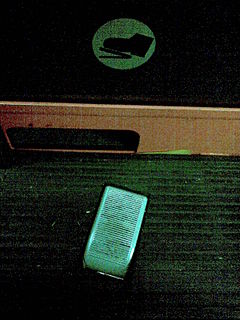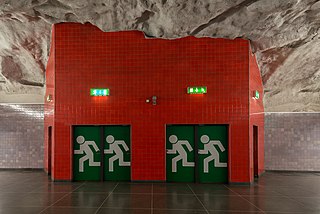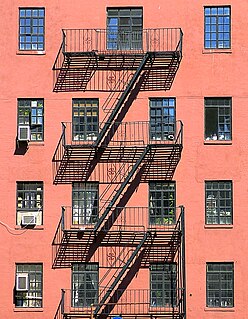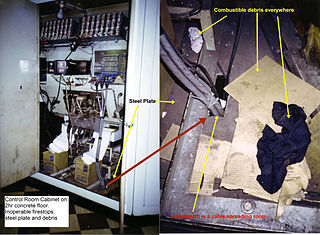
An alarm device is a mechanism that gives an audible, visual or other kind of alarm signal to alert someone to a problem or condition that requires urgent attention.

Stairs are a structure designed to bridge a large vertical distance by dividing it into smaller vertical distances, called steps. Stairs may be straight, round, or may consist of two or more straight pieces connected at angles.

An elevated passenger ropeway, or chairlift, is a type of aerial lift, which consists of a continuously circulating steel wire rope loop strung between two end terminals and usually over intermediate towers, carrying a series of chairs. They are the primary onhill transport at most ski areas, but are also found at amusement parks, various tourist attractions, and increasingly in urban transport.

Accessibility is the design of products, devices, services, vehicles, or environments so as to be usable by people with disabilities. The concept of accessible design and practice of accessible development ensures both "direct access" and "indirect access" meaning compatibility with a person's assistive technology.

A dead man's switch is a switch that is designed to be activated or deactivated if the human operator becomes incapacitated, such as through death, loss of consciousness, or being bodily removed from control. Originally applied to switches on a vehicle or machine, it has since come to be used to describe other intangible uses, as in computer software.

An aerial work platform (AWP), also known as an aerial device, elevating work platform (EWP), cherry picker, bucket truck or mobile elevating work platform (MEWP) is a mechanical device used to provide temporary access for people or equipment to inaccessible areas, usually at height. There are distinct types of mechanized access platforms and the individual types may also be known as a "cherry picker", "boom lift" or "scissor lift".

An emergency exit in a structure is a special exit for emergencies such as a fire: the combined use of regular and special exits allows for faster evacuation, while it also provides an alternative if the route to the regular exit is blocked.

An emergency light is a battery-backed lighting device that switches on automatically when a building experiences a power outage.

Emergency evacuation is the urgent immediate egress or escape of people away from an area that contains an imminent threat, an ongoing threat or a hazard to lives or property.

A fire escape is a special kind of emergency exit, usually mounted to the outside of a building or occasionally inside but separate from the main areas of the building. It provides a method of escape in the event of a fire or other emergency that makes the stairwells inside a building inaccessible. Fire escapes are most often found on multiple-story residential buildings, such as apartment buildings. At one time, they were a very important aspect of fire safety for all new construction in urban areas; more recently, however, they have fallen out of common use. This is due to the improved building codes incorporating fire detectors, technologically advanced fire fighting equipment, which includes better communications and the reach of fire fighting ladder trucks, and more importantly fire sprinklers. The international building codes and other authoritative agencies have incorporated fire sprinklers into multi-story buildings below 15 stories and not just skyscrapers.

Manual fire alarm activation is typically achieved through the use of a pull station or call point, which then sounds the evacuation alarm for the relevant building or zone. Manual fire alarm activation requires human intervention, as distinct from automatic fire alarm activation such as that provided through the use of heat detectors and smoke detectors. It is, however, possible for call points/pull stations to be used in conjunction with automatic detection as part of the overall fire detection and alarm system. Systems in completed buildings tend to be wired in and include a control panel. Systems for use during construction can also be wireless or mechanical, it is recommended by the Structural Timber Association in the UK that for timber-framed constructions, interconnecting wireless systems be used.

A stair lift is a mechanical device for lifting people, typically those with disabilities, up and down stairs. For sufficiently wide stairs, a rail is mounted to the treads of the stairs. A chair or lifting platform is attached to the rail. A person gets onto the chair or platform and is lifted up or down the stairs by the chair which moves along the rail.

An evacuation slide is an inflatable slide used to evacuate an aircraft quickly. An escape slide is required on all commercial aircraft where the door sill height is such that, in the event of an evacuation, passengers would be unable to step down from the door uninjured.

An area of refuge or safe room is a place in a building designed to hold occupants during a fire or other emergency when evacuation may not be safe or possible. Occupants can wait there until rescued or relieved by firefighters.

Window cleaning, or window washing, is the exterior cleaning of architectural glass used for structural, lighting, or decorative purposes. It can be done manually, using a variety of tools for cleaning and access. Technology is also employed and increasingly, automation.

A stairclimber is a type of trolley fitted with rotating wheels or tracks so that it can be pushed or pulled up or down steps or a stairway. Stairclimbers can be manual or battery-powered, and are commonly found in wheel, track, push arm or walker variants.

A wheelchair lift, also known as a platform lift, or vertical platform lift, is a fully powered device designed to raise a wheelchair and its occupant in order to overcome a step or similar vertical barrier.

A wheelchair is a chair with wheels, used when walking is difficult or impossible due to illness, injury, problems related to old age, or disability. These can include spinal cord injuries, cerebral palsy, brain injury, osteogenesis imperfecta, motor neurone disease, multiple sclerosis, muscular dystrophy, spina bifida, and more.
Accessible housing refers to the construction or modification of housing to enable independent living for persons with disabilities. Accessibility is achieved through architectural design, but also by integrating accessibility features such as modified furniture, shelves and cupboards, or even electronic devices in the home.

The European Union Persons with Reduced Mobility (PRM) legislation is intended to ensure that Persons with Reduced Mobility traveling via public transport, whether by air, land or sea, should have equal access to travel as compared to travelers with unrestricted mobility. Travel providers are compelled to provide and install sufficient access facilities to enable Passenger with Reduced Mobility to enjoy similar access to other passengers.



















